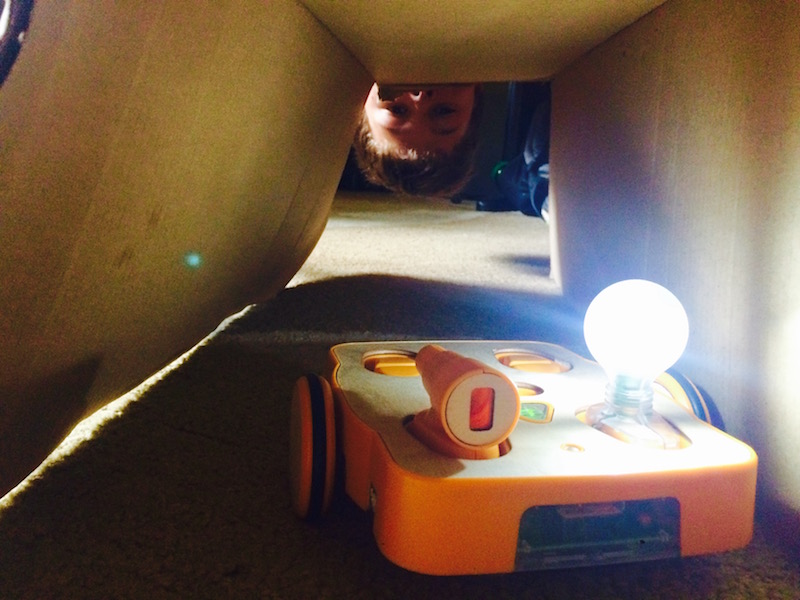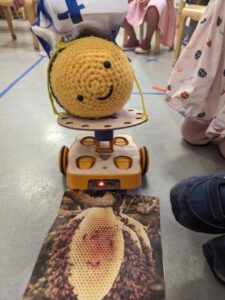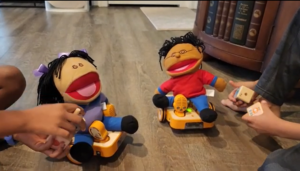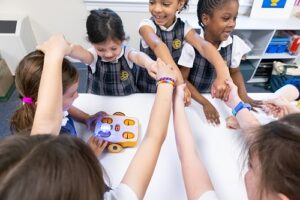KIBO the Cave Explorer at PS321
Contributed by: Brian Sulkow (aka "Professor Pi"), New York Public Schools, PS321, Brooklyn, NY, http://ps321.org

I’ve been working with New York City public schools as a STEM curriculum writer, and teacher for the past 10 years. Two years ago, a new and wonderful opportunity to teach lessons in coding using KIBO robots came to me. Since then I’ve recognized that KIBO is not only a fantastic tool for teaching coding, but it’s also a great tool for teaching students about the role of technology in our lives, communication skills, working in groups, problem solving skills, perseverance, and much more.
Today, robots are firefighters, explorers, and they help in the operating room too. With KIBO our youngest students can start to realize the great potential robots have for improving our lives. The curriculum I’ve written for KIBO uses the roles robots play now and will play in the future as a unifying theme.
Our KIBO’s take on some important jobs. In one lesson, students program them to rescue baby bears that are lost in deep dark caves. (Our caves are constructed with old cardboard boxes, the imagination of the students dresses them up.) They love to train KIBO to navigate the twists and turns of our caves. Most of all, they love programming with the light sensor and the light- if the cave gets dark and scary, then KIBO should turn on her flashlight!
To get through those caves students need to measure. How will they measure? Will they simply guess the measurement? Will they use some prior measurement knowledge, or use another method? KIBO allows you to introduce problem solving techniques that students can rely on for the rest of their lives. Some ones that we go over are:
* Trial and Error – If students haven’t seen anything like your current situation you can expect to be teaching a lesson about TRIAL AND ERROR problem solving.
* “Have I seen this before?” – If students have seen something comparable you can emphasize that they should use what they know to solve the problem. When faced with a problem it’s so important for students to ask “Have I seen something like this before?”
* Little Bite Size Pieces – For the caves we use cardboard boxes. We stitch them together to make one huge cave that has lots of twists and turns. Students see a big problem. That’s a great time to teach students how to break a big problem into little bite size pieces.
From my perspective, the most valuable lesson students learn with KIBO is how to deal with something that doesn’t go exactly the way they wanted it to. They learn about perseverance. When a group’s KIBO doesn’t do the things they want it to do, the group understands that it’s time to ask a few questions “What worked? What didn’t?“ and “How can I fix it?”. They learn to evaluate a situation, reprogram KIBO, and try again. Our class mantra is – “No Tears Just Good Idears”.
Keri Goldberg, a first grade teacher at PS 321, said “The students in my class couldn’t wait to get their hands on the coding blocks that would make their KIBO robots go. The lessons had a true spirit of experimentation – there were no mistakes, just lots of trials, observations, and cheers to get back to work! I wouldn’t be surprised if the future programmers and scientists among them remember this experience as one that sparked their interest in coding and creative problem solving.”
A class with KIBO weaves together so many essential skills. This little robot gives our youngest students the opportunity to have a deep, and exciting engineering experience.





















